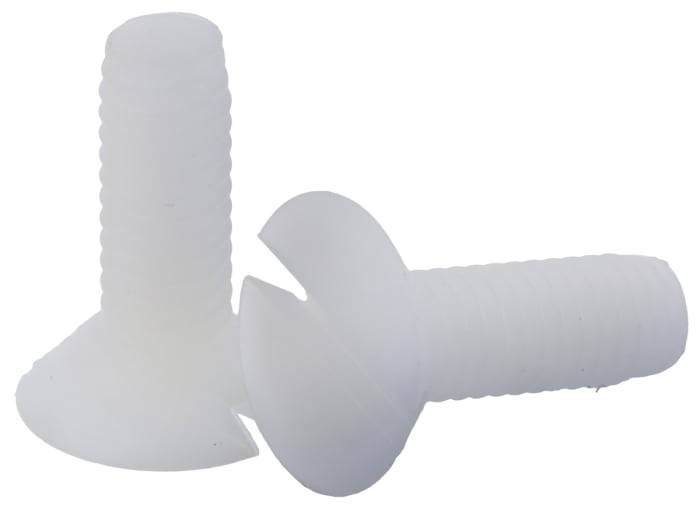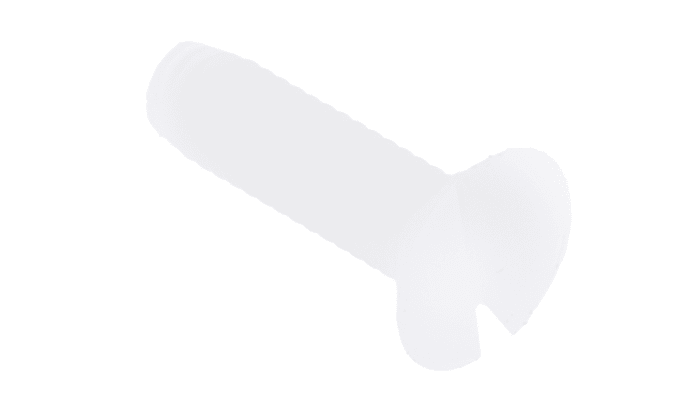RS PRO Slot Countersunk Nylon Machine Screws x 10mm

Technical Document
Specifications
Brand
RS ProHead Shape
Countersunk
Drive Type
Slot
Length Metric
10mm
Thread Size Metric
M3
Thread Size (Metric)
M3
Material
Nylon
Finish
Plain
Thread Pitch
0.5mm
Country of Origin
United States
Product details
RS PRO Nylon Slotted Countersunk Head Machine Screws
From RS PRO a high-quality machine screw with a flat countersunk head for flush fitting. The screw head is slotted for easy tightening with a flat blade screwdriver. This machine screw has a metric thread and is made from high-quality nylon making it strong, lightweight and resistant to corrosion. Nylon also has excellent electrical insulation properties making this machine screw ideal for use in electronics applications.
What is a Machine Screw?
A machine screw is similar to a bolt but has a socket or slot in its head that allows it to be turned by a screwdriver. The shank on a machine screw is straight rather than tapered with a full thread which is uniform along the entire length. Machine screws do not tap their own thread into materials like wood screws do but are designed to be fastened into pre-tapped holes in the parts they are fastening together. Having a threaded hole creates a stronger joint and results in a higher quality product.
What is a Countersunk Screw?
Countersunk machine screws, also known as CSK screws have a flat head design so when placed in a pre-drilled countersunk hole they will sit flush with or below the surface of the surrounding material. These screw head types are ideal for use when you need to cover the heads with a screw cap or create a flat surface for placing objects on or fixing other objects to.
Features and Benefits of Nylon Screws
• Durable and lightweight
• Corrosion resistant
• Resistant to greases and oils
• Abrasion and vibration resistant and less likely to wear and loosen over time or in rough conditions
• Good electrical and thermal insulating properties
• Resistant to a wide range of temperatures.
• Meets BS4183 Standards
What are Nylon Machine Screws Used For?
Machine screws are designed to hold separate components together in a wide range of manufacturing and electronic applications. They are screwed through pre-drilled tapped holes in 2 components and can be fastened at the rear with a nut. Nylon machine screws can be used as fasteners for a wide range of different materials including particle board, metal, wood, rubber and other plastics. Being made of nylon makes these screws ideal for use in devices where weight is a constraint. The excellent electrical insulation properties of nylon also make these machine screws ideal for use in electronics design. Applications include the following:
• Washing machines
• Household appliances
• Handheld devices
• Electronics and circuit boards
• Commercial machinery
• Automotive parts
What Does M2.5, M3, M3.5, M4, M5 Mean?
These measurements are found on metric screws, The 'M' stands for Metric. The number after the 'M' is the nominal outer diameter of the screw in mm.
How Do I Cut a Machine Screw?
Damage to the machine screw threads can prevent parts from fitting together properly, therefore care has to be taken when cutting them and the correct tools used.
Cutting a small machine screw (up to standard size #10 or metric size M5 (5mm)
Use a pair of multipurpose wire strippers or electricians pliers that feature M2.5, M3, M3.5, M4, M5 threaded holes. These holes are designed for cutting bolts without damaging the thread. Open the jaws and thread the machine screw into the correct size hole to the distance required. Squeeze the tool handles closed and the screw will be cut at the point where the two halves of the jaws come together. You will have a clean cut without any thread damage.
Cutting a large machine screw (larger than size #10 or metric size M5 (5mm)
This is best done using a hacksaw. Thread the nut on the screw until it reaches the desired point on the head side of the cutting line. Place the screw in a vice or clamp to keep it secure when cutting and cut the screw as straight as you can. When you unthread the nut it will repair and realign any threads that may have been damaged by the saw blade.
BD 7.980
BD 7.980 1 Bag of 100 (Exc. Vat)
BD 8.778
BD 8.778 1 Bag of 100 (inc. VAT)
1
BD 7.980
BD 7.980 1 Bag of 100 (Exc. Vat)
BD 8.778
BD 8.778 1 Bag of 100 (inc. VAT)
1
Stock information temporarily unavailable.
Please check again later.
| quantity | Unit price |
|---|---|
| 1 - 4 | BD 7.980 |
| 5 - 9 | BD 7.579 |
| 10 - 29 | BD 7.293 |
| 30+ | BD 6.902 |
Technical Document
Specifications
Brand
RS ProHead Shape
Countersunk
Drive Type
Slot
Length Metric
10mm
Thread Size Metric
M3
Thread Size (Metric)
M3
Material
Nylon
Finish
Plain
Thread Pitch
0.5mm
Country of Origin
United States
Product details
RS PRO Nylon Slotted Countersunk Head Machine Screws
From RS PRO a high-quality machine screw with a flat countersunk head for flush fitting. The screw head is slotted for easy tightening with a flat blade screwdriver. This machine screw has a metric thread and is made from high-quality nylon making it strong, lightweight and resistant to corrosion. Nylon also has excellent electrical insulation properties making this machine screw ideal for use in electronics applications.
What is a Machine Screw?
A machine screw is similar to a bolt but has a socket or slot in its head that allows it to be turned by a screwdriver. The shank on a machine screw is straight rather than tapered with a full thread which is uniform along the entire length. Machine screws do not tap their own thread into materials like wood screws do but are designed to be fastened into pre-tapped holes in the parts they are fastening together. Having a threaded hole creates a stronger joint and results in a higher quality product.
What is a Countersunk Screw?
Countersunk machine screws, also known as CSK screws have a flat head design so when placed in a pre-drilled countersunk hole they will sit flush with or below the surface of the surrounding material. These screw head types are ideal for use when you need to cover the heads with a screw cap or create a flat surface for placing objects on or fixing other objects to.
Features and Benefits of Nylon Screws
• Durable and lightweight
• Corrosion resistant
• Resistant to greases and oils
• Abrasion and vibration resistant and less likely to wear and loosen over time or in rough conditions
• Good electrical and thermal insulating properties
• Resistant to a wide range of temperatures.
• Meets BS4183 Standards
What are Nylon Machine Screws Used For?
Machine screws are designed to hold separate components together in a wide range of manufacturing and electronic applications. They are screwed through pre-drilled tapped holes in 2 components and can be fastened at the rear with a nut. Nylon machine screws can be used as fasteners for a wide range of different materials including particle board, metal, wood, rubber and other plastics. Being made of nylon makes these screws ideal for use in devices where weight is a constraint. The excellent electrical insulation properties of nylon also make these machine screws ideal for use in electronics design. Applications include the following:
• Washing machines
• Household appliances
• Handheld devices
• Electronics and circuit boards
• Commercial machinery
• Automotive parts
What Does M2.5, M3, M3.5, M4, M5 Mean?
These measurements are found on metric screws, The 'M' stands for Metric. The number after the 'M' is the nominal outer diameter of the screw in mm.
How Do I Cut a Machine Screw?
Damage to the machine screw threads can prevent parts from fitting together properly, therefore care has to be taken when cutting them and the correct tools used.
Cutting a small machine screw (up to standard size #10 or metric size M5 (5mm)
Use a pair of multipurpose wire strippers or electricians pliers that feature M2.5, M3, M3.5, M4, M5 threaded holes. These holes are designed for cutting bolts without damaging the thread. Open the jaws and thread the machine screw into the correct size hole to the distance required. Squeeze the tool handles closed and the screw will be cut at the point where the two halves of the jaws come together. You will have a clean cut without any thread damage.
Cutting a large machine screw (larger than size #10 or metric size M5 (5mm)
This is best done using a hacksaw. Thread the nut on the screw until it reaches the desired point on the head side of the cutting line. Place the screw in a vice or clamp to keep it secure when cutting and cut the screw as straight as you can. When you unthread the nut it will repair and realign any threads that may have been damaged by the saw blade.

